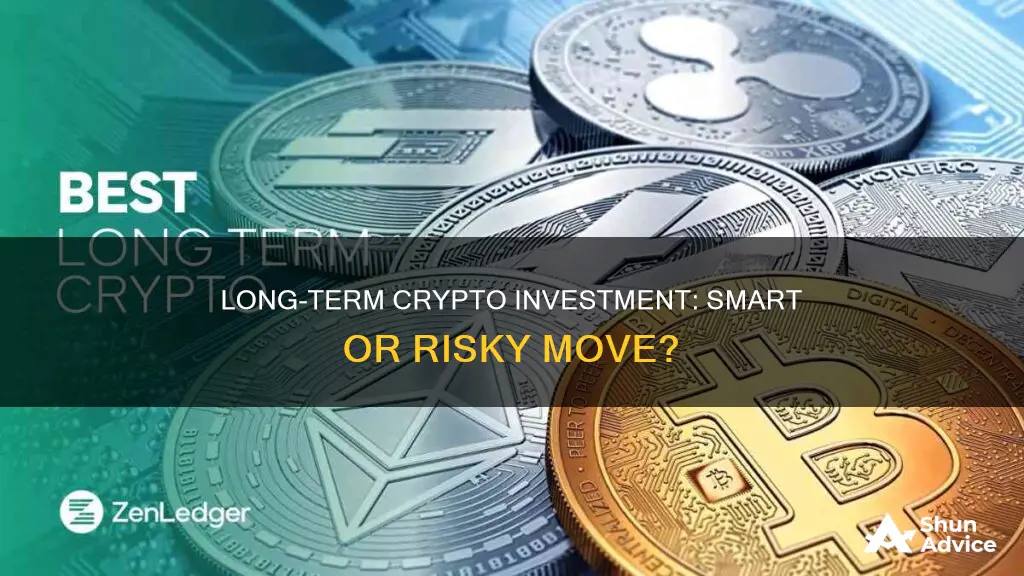
Cryptocurrency is a digital currency that is not managed by a central system like a government but is based on blockchain technology. The most popular cryptocurrency is Bitcoin, which has a fixed supply cap of 21 million BTC. Cryptocurrencies are extremely volatile and risky investments due to their high volatility and the potential for significant losses from security breaches. However, they offer impressive value propositions as small investments can yield substantial profits. For long-term investments, it is advisable to stick to the top coins by market capitalization, such as Bitcoin, Ethereum, and Cardano, which have shown greater stability and widespread adoption.
| Characteristics | Values |
|---|---|
| Volatility | Cryptocurrencies are extremely volatile and prone to large swings in both directions |
| Risk | Crypto investments are risky due to potential high losses from security breaches and scams |
| Diversification | Diversifying investments across multiple crypto assets can help minimize risk |
| Adoption | Increased adoption by companies and individuals suggests a maturing industry and potentially safer investments |
| Regulation | Regulatory actions by governments and the SEC can impact the crypto market |
| Technology | The underlying technology, such as blockchain and smart contracts, can drive crypto value and adoption |
| Supply | Limited supply, such as Bitcoin's 21 million BTC cap, can increase scarcity and value over time |
| Demand | Growing demand and network effects can drive crypto value, such as with Bitcoin and Ethereum |
| Decentralization | Decentralized decision-making and absence of centralized entities can impact investment strategies |
| Sentiment | Market sentiment and hype can significantly influence crypto prices, as seen with Dogecoin |
What You'll Learn

Bitcoin's fixed supply cap
Bitcoin has a fixed supply cap of 21 million BTC, which is rewarded to miners for securing the network. This hard cap, also known as the supply limit, can theoretically be changed, but it is very unlikely. There are incentive and governance models in the bitcoin protocol that protect the hard cap.
The Bitcoin hard cap is the maximum number of bitcoin that can ever be created, and it is a key feature of Bitcoin’s monetary policy. It is designed to create scarcity and prevent inflation. The hard cap is reached through the process of halving, where the reward for mining new blocks is cut in half approximately every four years, gradually reducing the rate at which new bitcoins are created until the hard cap or limit is reached. It is estimated that the last bitcoin will be mined around 2140, bringing the supply to a total of 21 million.
Bitcoin’s hard cap is central to its value proposition, both as a currency and an investment. Like gold and real estate, Bitcoin is a successful store of value because it is difficult to increase its supply. Thanks to the halving process, bitcoin becomes more difficult to produce about every four years, and eventually, it will become impossible to create new bitcoins. This scarcity is one of the reasons why many investors value Bitcoin highly.
The decision to cap Bitcoin’s supply at 21 million was an “educated guess” by Satoshi Nakamoto, the creator of Bitcoin. The rationale behind this decision was to make prices denominated in Bitcoin comparable to existing currencies. Bitcoin offers a high degree of divisibility, allowing for flexibility in pricing. Each bitcoin can be divided into 100 million units called satoshis. This high level of divisibility allows for flexibility in payments, accommodating a wide range of values. Even if the value of one bitcoin becomes very high, transactions of very small amounts are still possible, making Bitcoin practical for everyday use and ensuring its utility across various economic scales.
The hard cap on Bitcoin is critical to its value proposition as a currency and an investment tool. Bitcoin, like gold and real estate, is a successful store of value because its quantity is difficult to expand. Every four years, due to halving, producing Bitcoin becomes more complex and finally impossible.
Shiba Inu Coin: A Guide to US Investment
You may want to see also

Altcoin investments
Altcoins are generally defined as all cryptocurrencies other than Bitcoin (BTC). However, some people consider altcoins to be all cryptocurrencies other than Bitcoin and Ethereum (ETH) because most cryptocurrencies are forked from one of the two.
Altcoins come in several types based on what they were designed for. Here are some of the most common types:
- Payment tokens: Designed to be used as currency to exchange value between parties. Bitcoin is the prime example of a payment token.
- Stablecoins: Aim to reduce volatility by pegging value to another asset, such as gold or the US dollar. Examples include Tether (USDT) and USD Coin (USDC).
- Security tokens: Represent ownership in an asset or fundraising efforts. They are regulated by the Securities and Exchange Commission (SEC) as they are designed to act as securities.
- Utility tokens: Used to provide services within a network, such as purchasing services or paying network fees. Filecoin is an example of a utility token.
- Meme coins: Inspired by a joke or a silly take on other well-known cryptocurrencies. Dogecoin (DOGE) and Shiba Inu (SHIB) are popular examples.
- Governance tokens: Allow holders certain rights within a blockchain, such as voting for changes to protocols.
When considering investing in altcoins, it is important to keep in mind that they are generally more volatile and speculative than Bitcoin. They may also have lower liquidity and struggle to gain widespread adoption. However, altcoins offer opportunities for high returns and innovation, with many aiming to address perceived weaknesses in Bitcoin's design.
- Conduct thorough research on the project, including its use cases, road map, team, and technology used.
- Do a risk assessment considering factors such as market volatility and regulatory challenges.
- Diversify your investments across different altcoins to minimize risk.
- Choose a reliable cryptocurrency exchange with strong security measures and a user-friendly interface.
- Stay informed and conduct due diligence to keep up with the fast-paced nature of the crypto market.
Multi-Bots for Crypto: Worth the Investment?
You may want to see also

Crypto market unpredictability
The crypto market is notoriously unpredictable and volatile, presenting both incredible gains and devastating losses. The market's unpredictability is underscored by its sharp declines and rapid growth periods, making it challenging for investors to navigate. This unpredictability is driven by several factors, including:
Investor Sentiment
Positive or negative news, as well as adoption stories, can rapidly shift market dynamics and investor sentiment, leading to price swings. The fear of missing out (FOMO) can also fuel market growth as more investors join, attracted by rising prices.
Market Adoption
The increased use of cryptocurrencies by businesses and consumers enhances their credibility and value, potentially boosting market cycles. On the other hand, slow adoption can stagnate prices and impact the market negatively.
Regulatory Changes
Announcements about crypto regulations or government stances can have a significant impact on the market. Favourable regulations can validate the legitimacy of cryptocurrencies and spur growth, while uncertainty and negative regulatory changes can contract the market.
Technological Advancements
Blockchain technology advancements and the introduction of new crypto platforms or tokens can significantly influence market cycles by enhancing utility and attracting investors.
Macroeconomic Factors
Global economic health, inflation, and interest rate changes also play a role in shaping crypto market cycles. During economic instability, investors may turn to cryptocurrencies as a hedge, impacting the demand and value.
Strategies for Navigating Unpredictability
To effectively navigate the unpredictable crypto market, investors should adopt a strategic mindset, acknowledging that the market can defy traditional forecasting methods. Diversifying portfolios, practising risk management, and adopting a long-term perspective are crucial. Additionally, investors can benefit from understanding market cycles and their phases, such as accumulation, uptrend, distribution, and downtrend, allowing for more informed investment decisions.
JST Coin: A Smart Investment Decision?
You may want to see also

Centralized vs. decentralized exchanges
As a cryptocurrency trader or investor, you have the choice between centralized and decentralized exchanges. Here are some of the key differences between the two:
Centralized Exchanges (CEX)
- Run by a third party that monitors, facilitates transactions and secures assets
- Regulated by financial authorities and operate under KYC and AML regulations
- Faster and easier to use with a slick user experience and clean interfaces
- Trades are settled near-instantly
- Retain custody of the assets, meaning the user relies on the exchange to honour its commitment and process transfers of their cryptocurrency
- Frequently the target of hacker attacks
- Offer fiat/crypto trading pairs
- More liquidity, allowing for larger trades
Decentralized Exchanges (DEX)
- Run on a system of smart contracts without centralized oversight, making them permissionless
- Clunkier, slower and require more experience to navigate
- Trades are matched by an automated market maker, a system that provides liquidity for trading pairs of cryptocurrencies
- The user retains custody of their private key and thus their cryptocurrency
- Generally considered safer, although there have been DEX hacks
- Offer a wide variety of crypto-to-crypto trading pairs
- May be cheaper for individual trades but can be more expensive overall due to gas fees
- Not regulated due to processing all trades on public blockchains
In summary, CEXs are more user-friendly and regulated, but come with higher risks of hacking and fraud. DEXs offer more control and potentially lower fees, but are less liquid and require more knowledge to use.
Robinhood's Bitcoin: Safe Investment or Risky Business?
You may want to see also

Crypto as a long-term investment strategy
Investing in cryptocurrencies is risky due to the potential for high losses from security breaches and fraud. However, it can also be lucrative, with some investors making huge profits. Crypto is a highly volatile asset class, and investors need to be prepared for significant price swings.
Bitcoin as a long-term investment
Bitcoin is the world's largest cryptocurrency and is often referred to as "digital gold". It benefits from the network effect, with more people wanting to own it because it is the most widely held crypto. Bitcoin has a fixed supply cap of 21 million coins, and its supply rate is halved every four years or so, making it increasingly scarce over time. This scarcity, combined with its decentralised nature and the fact that its supply is not controlled by central bankers, means many investors believe it will gain value over the long term.
Ethereum as a long-term investment
Ethereum is a decentralised blockchain platform that enables the creation and execution of smart contracts. It is the second-largest cryptocurrency by market cap and is far ahead of its competitors in terms of unique technology. Its native coin, ether, has gained widespread acceptance, with many companies coming on board.
Other cryptos for long-term investment
Other cryptocurrencies that have been mentioned as good long-term investments include Cardano, Binance Coin, Polkadot, and Tether.
Diversification
Most cryptocurrency investors minimise risk by diversifying their portfolios across multiple assets.
Final thoughts
Cryptocurrency is a risky but potentially rewarding long-term investment. It is important to do your research and only invest what you can afford to lose.
The Crypto Investment: Which Coins are Worthy?
You may want to see also
Frequently asked questions
Crypto is a risky investment due to its volatility and susceptibility to security breaches. However, it can be a good long-term investment if you do your research, invest in multiple assets, and make investments as part of a diversified portfolio.
Some cryptocurrencies that have been topping the market cap charts include Bitcoin, Ethereum, Cardano, Binance Coin (BNB), and Tether.
Fundamental analysis, technical analysis, and quantitative analysis are three methods investors use to gauge the upside and risk of a particular asset. It is important to do your own research and only invest money you are willing to lose.
The crypto market is infamously unpredictable, creating millionaires just as often as it bankrupts investors. There is no centralized entity to hold responsible, which makes the blockchain industry perfect for running scams. Additionally, crypto exchanges are vulnerable to being hacked and becoming targets of other criminal activity.







